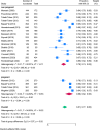Varicella-zoster virus seroprevalence among reproductive-age women in Iran: a meta-analysis and implications for targeted immunization
- PMID: 40826384
- PMCID: PMC12359889
- DOI: 10.1186/s12879-025-11415-2
Varicella-zoster virus seroprevalence among reproductive-age women in Iran: a meta-analysis and implications for targeted immunization
Abstract
Background: Primary varicella-zoster virus (VZV) infection during pregnancy poses significant risks to both mother and fetus, including congenital varicella syndrome (CVS) and serious maternal complications. In Iran, the absence of varicella vaccination in the national immunization program leaves many women susceptible. This systematic review and meta-analysis aimed to determine the overall seroprevalence of VZV antibodies among reproductive-age women in Iran.
Methods: A comprehensive search was conducted in both international and Iranian databases for studies published up to November 15, 2024. Eligible studies reporting VZV seroprevalence among Iranian women aged 15-49 years were identified. Screening, data extraction, and risk of bias assessment were independently performed by two reviewers. Pooled seroprevalence was estimated using a random-effects meta-analysis in STATA version 18. Heterogeneity was evaluated with the Cochrane Q test and I² statistic. Subgroup analyses and meta-regression explored sources of heterogeneity. Sensitivity analyses (leave-one-out) and publication bias (Doi plot, LFK index) were also performed. The protocol was registered in PROSPERO (CRD42025647813).
Results: Data from 20 studies, including 5,629 participants, were analyzed. A pooled VZV seroprevalence of 81% (95% CI: 77-85%) was found, indicating that approximately 19% of reproductive-age women in Iran remain susceptible. Higher seroprevalence was observed in pregnant women (88%) compared with non-pregnant women (79%), with the lowest rates among medical students (74%). Despite subgroup and meta-regression analyses, substantial heterogeneity remained unexplained. Sensitivity analyses supported the robustness of the results, while possible publication bias was suggested.
Conclusions: Nearly one in five reproductive-age women in Iran lack immunity to VZV. Targeted vaccination, especially among non-pregnant women and students, may reduce susceptibility. Preconception screening for VZV immunity could help prevent maternal and fetal complications. However, given the high unexplained heterogeneity, results should be interpreted with caution.
Keywords: Chickenpox; Human herpesvirus 3; Immunization; Iran; Seroepidemiologic studies; Varicella-Zoster virus; Women.
© 2025. The Author(s).
Conflict of interest statement
Declarations. Ethics approval and consent to participate: Not applicable. Consent for publication: Not applicable. Competing interests: The authors declare no competing interests. Clinical trial number: Not applicable.
Figures




Similar articles
-
A systematic review and meta-analysis of seroprevalence of varicella zoster virus: A nationwide population-based study.J Clin Virol. 2017 Feb;87:49-59. doi: 10.1016/j.jcv.2016.12.001. Epub 2016 Dec 6. J Clin Virol. 2017. PMID: 28011413
-
Interventions targeted at women to encourage the uptake of cervical screening.Cochrane Database Syst Rev. 2021 Sep 6;9(9):CD002834. doi: 10.1002/14651858.CD002834.pub3. Cochrane Database Syst Rev. 2021. PMID: 34694000 Free PMC article.
-
Multiple-micronutrient supplementation for women during pregnancy.Cochrane Database Syst Rev. 2017 Apr 13;4(4):CD004905. doi: 10.1002/14651858.CD004905.pub5. Cochrane Database Syst Rev. 2017. Update in: Cochrane Database Syst Rev. 2019 Mar 14;3:CD004905. doi: 10.1002/14651858.CD004905.pub6. PMID: 28407219 Free PMC article. Updated.
-
Strategies of testing for syphilis during pregnancy.Cochrane Database Syst Rev. 2014 Oct 29;2014(10):CD010385. doi: 10.1002/14651858.CD010385.pub2. Cochrane Database Syst Rev. 2014. PMID: 25352226 Free PMC article.
-
Systemic treatments for metastatic cutaneous melanoma.Cochrane Database Syst Rev. 2018 Feb 6;2(2):CD011123. doi: 10.1002/14651858.CD011123.pub2. Cochrane Database Syst Rev. 2018. PMID: 29405038 Free PMC article.
References
-
- Moattari A, Ghanbari Asad A, Mansouri A, Malehi Vaziri M, Moradpour Shammami F. Evaluation of measles, rubella, mumps, hepatitis B and varicella Zoster antibodies in medical and dental students in shiraz, Iran. Novel Biomed. 2014;2(1):6–9.
-
- Sharifi Z, Emadi G. The seroepidemiology of varicella Zoster virus (VZV) in different age groups in tehran, Iran. Iran J Allergy Asthma Immunol. 1970;4(2). - PubMed
-
- Amjadi O, Rafiei A, Haghshenas M, Navaei RA, Valadan R, Hosseini-Khah Z, et al. A systematic review and meta-analysis of Seroprevalence of varicella Zoster virus: A nationwide population-based study. J Clin Virol. 2017;87:49–59. - PubMed
Publication types
LinkOut - more resources
Full Text Sources

